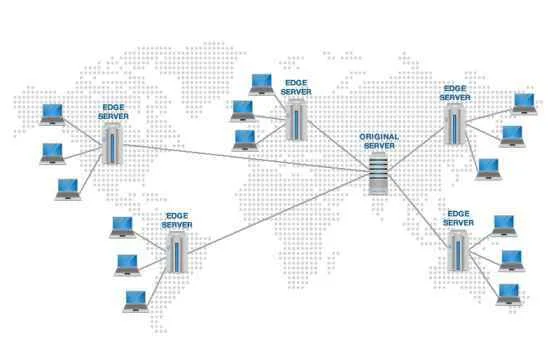A content delivery network (CDN) speeds up almost any website by caching its files on servers around the world. Whether your visitors are from Europe, North America, Asia or elsewhere, content is automatically served from the closest location at the fastest possible speeds.
When you’re new to the technology it can be intimidating, and there’s no doubt the prices can be high, but don’t let that put you off. A CDN is not just intended for large companies. You can get the simplest services up and running in less than five minutes, and if you choose your plan carefully, it may cost you nothing at all.
A content delivery network (CDN) is a globally distributed network of points of presence (PoP) designed to provide faster and more reliable content delivery to users. Whether we know it or not, each of us interacts with CDNs on a daily basis; when reading articles on news sites, shopping online, watching Netflix, or browsing social media feeds. CDN is the helper behind your perfect experience.
It helps minimise loading time, costs, delivery latency and operational complexity by physically reducing the distance between content providers and users around the world.
How does CDN work?
If a US user wants to load a website hosted in China, the user must send a request to the China origin, and the origin will then send content from China to the US However, it will take longer for the content to load and could affect the user experience. This is where CDN comes in. CDN stores a copy of the content on its own PoPs around the world. Based on the location of the users, CDN makes the content available to users from nearby PoPs whenever possible.

What are the benefits of using CDN?
- Faster load time: Instead of sending requests to the origin and waiting for their response, the user will receive content from the nearby CDN PoP to reduce latency.
- Higher scalability: CDN can serve 40 to 200 Tbps at peak traffic. It can provide continuous experience globally, even in unpredictable situations such as malicious attacks or original failure.
- Better security: CDN acts as a proxy in front of the origin server, which adds an extra layer of security by hiding the real IP of the origin.
- Lower bandwidth costs: By optimizing the cache and requests, CDN helps content providers reduce delivery costs significantly as most of the traffic no longer leaves the source.
Why is CDN essential in this pandemic?
Due to COVID-19, most people use digital platforms more often to work, attend online classes, watch live broadcasts, play games, etc. Due to the enormous amount of traffic, the entire digital flow becomes more sensitive to latency and security.
CDN can help you deliver your content fast, secure and hassle-free, ensuring a consistent and optimised user experience across the globe.
BUNNY CDN
If you’re looking for a CDN that won’t cost you a fortune, then you should consider BunnyCDN.
It may have a slightly frivolous name, but Bunny, based in Slovenia, is a serious CDN with a decent set of features, its own Tier 1 network (with over 10 Tier 1 partners) and over 10,000 customers including Comic- Con and Hyundai.
Bunny’s network includes 53 locations, including 19 in Europe, 13 in North America, 16 in Asia and Oceania, three in the Middle East and Africa, and two in South America.
The company offers the key features you’ve come to expect, including HTTP/2 and Brotli compression, free Let’s Encrypt SSL, IP blocking access control, and a powerful rules-based system that gives you control over authentication, routing, delivery and more edge servers.
File optimisation is another highlight, with Bunny automatically reducing your CSS and JavaScript files to increase speed.
Smart image optimisations include Bunny’s ability to automatically resize and compress your images to fit the end user’s device (no need to serve these huge, detailed images to the user’s tiny, low-resolution screen).
The engine also supports dynamic image processing through its simple query API. You can resize images, adjust quality, sharpen and blur, change brightness, saturation, hue and more (read more about this and other low-level service details on the Bunny support site).
When is the best time to use Bunny CDN?
Often hosting providers offer cheap hosting plans on overloaded and highly populated low performance servers. This generally has a large impact on your website loading speed, site performance and causes a poor user experience.
If you find yourself stuck with hosting provider offering poor hosting performance. Bunny CDN is the best solution for general websites.
Bunny CDN will give you a free 14 day trial with 1Tb of usage.
Pricing
Bunny’s pricing scheme isn’t the simplest we’ve seen, but it’s such a good overall value that you’re unlikely to mind.
For example, the Standard Network plan charges different rates for each region, but just look at the numbers: $ 0.01 per GB in Europe and North America, $ 0.03 in Asia and Oceania, $ 0.045 in South America, and 0. 06 USD in the Middle East and Africa. Pricing quickly starts at $ 0.12 per gigabyte for the first 10 TB, and in South Africa to $ 0.28.
The Bunny volume network only supports eight locations, but they are capable of handling the most demanding sites. Pricing starts at just $ 0.005 for the first 100 TB, and that’s a flat rate; there are no regional differences.
Extras include File and Image Optimizer at $ 9.50 per month per website, and CDN storage ranging from $ 0.01 per GB in Europe and North America to $ 0.03 in Australia . There’s no minimum or additional charge for requests, so if you’re happy with 2GB storage in each of the five regions, you’ll only pay an extra $ 0.22 per month.
The company claims that its file storage allows you to get download speeds up to 5 times faster compared to major vendors (one-third the average global latency of Amazon S3, for example, and about twice the average speed of DigitalOcean).
There is no minimum contract with peripheral storage, so if the service isn’t working for you, cancel the storage item from your plan and you might not have spent more than a dollar or two.
And if you’re tight on cash and spend a dollar or two yourself, good news is: Bunny has a 14-day free trial with a generous 1TB of traffic, enough to try it out with even the busiest of websites.
There are a handful of providers with lower prices. AdvancedHosting CDN’s starter plan offers 10 TB of traffic per month, 50 GB of storage, and unlimited domains for just $ 25 per month (that’s $ 0.0025 per GB). On the flip side, it doesn’t have the features or support that you get with Bunny, so it might not be the bargain that it comes up with first.
Features
BunnyCDN is a phenomenal CDN platform with lots of features to tune and optimize your website. The best part about it is the incredible cost, coupled with outstanding performance and delivery. The image optimization is by far the best for the price.
Set up an extraction or storage area and Bunny presents you with a decent set of options.
Origin Shield’s support instructs Bunny to copy your content to one of her locations and serve it from there, minimizing the load on your server.
A handy collection of caching tools gives you a lot of control over the operation of the service.
The server timeout (the amount of time Bunny waits before downloading new content) can be set anywhere from three minutes to a year, and queries can be changed to increase the likelihood of cache hits (given that ‘image.jpg? Width = 200 & height = 100 ‘and’ image.jpg? Height = 100 & width = 200 ‘are the same file).
Moreover, other files can be cached with different parameters to create multiple cache entries (you can cache a different image.jpg for each user’s country code, say).
Performance
It is difficult to provide a reliable measure of CDN performance because every website is different. Speeds may vary depending on the number of visitors, their geographic distribution, your CMS or website platform, CDN settings, and how you take advantage of its more advanced features.
Benchmarking site CDNPerf may not tailor its results to your specific situation, but it collects real user metrics from over 300 million tests per day, and that gives us at least a benchmark figure for comparisons.
DNPerf ranks Bunny as 13th out of 20th among average response times worldwide. While not spectacular, it overcomes some familiar names including StackPath CDN (14.), KeyCDN (15.), and CacheFly (17.) and is only milliseconds behind most of the rest. For example, Bunny’s response time averaged 38 ms, but there was only four milliseconds between Bunny and five consecutive higher position CDNs.
Worldwide CDNPerf Average is a good place to start, but the website also provides response times for different regions and shows some interesting differences.
Bunny’s results in North America are the worst of all, with the company in 16th place out of 20. The company has reached a respectable ninth place for Africa, however, and peaked at an excellent 5th place for Oceania.
Setup
BunnyCDN supports multiple CMS ‘out of the box – you can install a plugin in WordPress, Drupal and some other CMS’, which makes it take less than 5 seconds to fully integrate BunnyCDN into your website.
If you have a custom website, you can simply rewrite your referral URLs for BunnyCDN.
Pull zones separate sites on BunnyCDN – this allows you to easily manage each site independently and see statistics and costs for each site. You can also link your put zones to pull zones, allowing you to easily link items in your put zones across sites
Concluding
If you own a website, you know that speed is important. That’s where BunnyCDN comes in – it lets you view assets and images from an ultra-fast server from 36 locations worldwide. This allows you to save server load and also dramatically speed up page rendering time.







